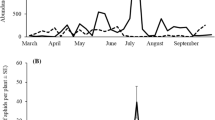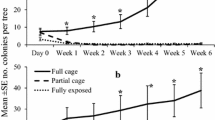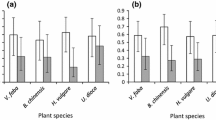Abstract
The impact of natural coccinellid larvalpredation on the balsam twig aphid was evaluated bysystematically removing coccinellid egg masses in a6–8 year-old balsam fir (Abies balsamea)Christmas tree plantation in southwesternQuebec. Among coccinellid species hunting on firfoliage during development of Mindarus abietinusfundatrices in May, the indigenous Anatis mali was by far the most abundant and themain one to oviposit on trees. Comparison of trees onwhich coccinellid larval predation was excluded withcontrol trees showed that A. mali had a markedimpact both during and after the phase of rapid M. abietinus population growth that followedfundatrix maturation. On trees where coccinellidlarvae were allowed, aphid colonies became inactive(i.e. no live aphids in the colony) about two weeksearlier than on controls. A strong dampening effect onaphid density was also observed in those colonies thatremained active until the end of the aphid life cycle.Predation on aphid colonies reduced sexualsproduction, as the density of M. abietinusoverwintering eggs per shoot subsequently was reducedby 32%. Predation by coccinellid larvae occurred toolate to prevent needle damage to current year shoots,which affects the aesthetic value of Christmas trees.However, current year shoots measured in the mid-crownof trees late in the season were 19% longer on treeswhere aphid predation by coccinellid larvae wasallowed, compared with trees where they were excluded.Rearing all larval stages of A. mali on 4thinstar and adult sexuparae of M. abietinusindicated an average consumption of 269 aphids tocomplete larval development and pupate, which wasequivalent to at least seven colonies of M.abietinus at maximum aphid density at theexperimental site. Anatis mali is an importantnatural control factor of balsam twig aphid inChristmas tree plantations, hence its activity shouldbe protected and possibly stimulated by favourablepest management practices.
Similar content being viewed by others
References
Amman, G.D., 1963. A new distribution record for the balsam twig aphid. J.Econ.Entomol. 56: 113.
Ben Saad, A.A. and G.W. Bishop, 1976. Attraction of insects to potato plants through use of artificial honeydews and aphid juice. Entomophaga 21: 49–57.
Berthiaume, R., 1998. Les ennemis naturels du puceron des pousses du sapin, Mindarus abietinusKoch (Homoptera: Aphididae), avec une emphase particulière sur les coccinelles Anatis maliSay et Harmonia axyridis Pallas. Mémoire de Maîtrise. Université Laval, Québec. 121 pp.
Bradbury, R.L. and E.A. Osgood, 1986. Chemical control of balsam twig aphid, Mindarus abietinus Koch (Homoptera: Aphididae). Maine Agricultural Experiment Station, University of Maine. Technical bulletin 124. 12 pp.
Coderrre, D., E. Lucas and I. Gagné, 1995. The occurrence of Harmonia axyridis(Pallas) (Coleoptera: Coccinellidae) in Canada. Can.Entomol. 127: 609–611.
Deland, J.P., R. Berthiaume, C. Hébert and C. Cloutier, 1998. Programme alternatif de protection du sapin de Noël contre le puceron des pousses dans le contexte d'une saine gestion des ressources environnementales. Rapport final. Projet de recherche en technologie et environnement. Ministère de l'Environnement et de la Faune du Québec, Québec, 105 pp.
Desrosiers, N. 1998. Influence de la fertilisation azotée et de la date de débourrement sur les populations du puceron des pousses du sapin, Mindarus abietinusKoch (Homoptère: Aphididae). Mémoire de Maîtrise. Université Laval, Québec. 109 pp.
Dixon, A.F.G., 1998. Biology of Aphids. Edward Arnold, London. 58 pp.
Elliot, N.C. and R.W. Kieckhefer, 1990. Dynamics of aphidophagous coccinellid assemblages in small grain fields in eastern South Dakota. Environ.Entomol. 19: 1320-dy1329.
Ewert, B.M. and H.C. Chiang, 1966. Dispersal of three species of coccinellids in corn fields. Can.Entomol. 98: 999–1003.
Frazer, B.D. and B. Gill, 1981. Hunger, movement, and predation of Coccinella californica on pea aphids in the laboratory and in the field. Can.Entomol. 113: 1025-dy1033.
Frazer, B.D. 1988. Coccinellidae. Chapter 9.2.1. In: A.K. Minks and P. Harrewijn (eds), Aphids, Their Biology, Natural Enemies and Control, Volume 2B. Elsevier, Amsterdam. pp. 231–247.
Gawande, R.B., 1966. Effect of constant and alterning temperatures on feeding and development of Chilomenes sexmaculata Fb. In: I. Hodek (ed), Ecology of Aphidophagous Insects. Academia, Prague & Dr W. Junk, The Hague. pp. 63–67.
Gordon, R.D., 1985. The Coleoptera (Coccinellidae) of America, north of Mexico. J.New York Entomol.Soc. 93: 1–912.
Gurney, B. and N.W. Hussey, 1970.Evaluation of some coccinellid species for the biological control of aphids in protected cropping. Ann.Appl.Biol. 65: 451–458.
Hagen, K.S., 1962. Biology and ecology of predaceous Coccinellidae. Annu.Rev.Entomol. 7: 289–326.
Hemptinne, J.-L. and A.F.G. Dixon, 1997. Are aphidophagous ladybirds (Coccinellidae) prudent predators? Entomol.Res.Organ.Agric. 1997: 151–159.
Hodek, I., 1967. Bionomics and ecology of predaceous Coccinellidae. Annu.Rev.Entomol. 12: 79–104.
Hodek, I., 1970. Coccinellidae and the modern pest management. Bioscience 20: 543–552.
Hodek, I., 1973. Biology of Coccinellidae. Academia, Prague & Dr W. Junk. The Hague. 260 pp.
Hodek, I., 1993. Habitat and food specificity in aphidophagous predators (a review). Biocontrol Sci.Technol. 3: 91–100.
Hodek, I. and A. Honek, 1996. Ecology of Coccinellidae. Kluwer, Boston. 464 pp.
Iablokoff-Khnzorian, S.M., 1982. Les coccinelles (Coléoptères-Coccinellidae) des régions paléartique et orientale. Boubée, Paris. 568 pp.
Ives, P.M., 1981. Feeding and egg production of two species of coccinellids in the laboratory. Can.Entomol. 113: 999–1005.
Jervis, M. and N. Kidd, 1996. Insect Natural Enemies: Practical Approaches to Their Study and Evaluation. Chapman & Hall, London.491 pp.
Kirby, K.N., 1993. Advanced Data Analysis with SYSTAT. Van Nostrand Reinhold, New York. 475 pp.
Kleintjes, P.K., 1997. Midseason insecticide treatment of balsam twig aphids (Homoptera: Aphididae) and their aphidophagous predators in a Wisconsin Christmas tree plantation. Environ.Entomol. 26: 1393–1397.
Kring, T.J., F.E. Gilstrap and G.J. Michels, 1985. Role of indigenous coccinellids in regulating greenbugs (Homoptera: Aphididae) on Texas grain sorghum. J.Econ.Entomol. 78: 269–273.
Lapchin, L., A. Ferran, G. Iperti, J.M. Rabasse and J.P. Lyon, 1987. Coccinellids (Coleoptera: Coccinellidae) and syrphids (Diptera: Syrphidae) as predators of aphids in cereal crops: A comparison of sampling methods. Can.Entomol. 119: 815–822.
Larochelle, A., 1979. Les Coléoptères Coccinellidae du Québec. Cordulia, suppl. No 10. 111 pp.
Luck, R.F., B.M. Shepard and P.E. Kenmore, 1988. Experimental methods for evaluating arthropod natural enemies. Annu.Rev.Entomol. 33: 361–391.
Martineau, R., 1985. Insectes nuisibles des forêts de l'est du Canada. Marcel Brocquet, Laprairie QC. 283 pp.
Mensah, R.K. and J.L. Madden, 1994. Conservation of two predator species for biological control of Chrysophtharta bimaculata(Coleoptera: Chrysomelidae) in Tasmanian forests. Entomophaga 39: 71–83.
Mills, N.J., 1982. Voracity, cannibalism and coccinellid predation. Ann.Appl.Biol. 101: 144–148.
Nettleton, W.A. and F.P. Hain, 1982. The life history, foliage damage, and control of the balsam twig aphid, Mindarus abietinus(Homoptera: Aphididae), in fraser fir Christmas tree plantations of western North Carolina. Can.Entomol. 114: 155–165.
Obrycki, J.J. and M.J. Tauber, 1981.Phenology of three coccinellid species: thermal requirements for development. Ann.Entomol.Soc.Am. 74: 31–36.
Rather, M. and N.J. Mills, 1989. Possibilities for the biological control of Christmas tree pests, the balsam gall midge Paradiplosis tumifexGagné (Diptera: Cecidomyiidae) and the balsam twig aphid, Mindarus abietinusKoch (Homoptera: Mindaridae), using exotic enemies from Europe. Biocontr.News Inform. 10: 119–129.
Rice, M.E. and G.E. Wilde, 1988. Experimental evaluation of predators and parasitoids in suppressing greenbugs (Homoptera: Aphididae) in sorghum and wheat. Environ.Entomol. 17: 836–841.
Rondeau, G. and J.L. DesGranges, 1991. Effets des arrosages du diazinon (basudin), du diméthoate (cygon) et du savon insecticide (saferTM) sur la faune avienne dans les plantations de sapins de Noël. Service canadien de la faune, région de Québec. Série de rapports techniques, No 141. 54 pp.
Rose, A.H. and O.H. Lindquist, 1994. Insectes des épinettes, du sapin et de la pruche de l'est du Canada. Ressources naturelles Canada, Ottawa. 159 pp.
Schiefelbein, J.W. and H.C. Chiang, 1966.Effects of spray of sucrose solution in a corn field on the populations of predatory insects and their prey. Entomophaga 11: 333–339.
Smith, B.C., 1965. Differences in Anatis maliAuct. and Coleomegilla maculata lengi Timberlake to changes in the quality and quantity of the larval food (Coleoptera: Coccinellidae). Can.Entomol. 97: 1159–1166.
Smith 1966. Variation in weight, size, and sex ratio of coccinellid adults (Coleoptera: Coccinellidae). Can.Entomol. 98: 639–644.
Smith, C.C., W.R. Newell and T.R. Renault, 1981. Common insects and diseases of balsam fir Christmas trees. Canadian Forestry Service. Technical Note. No 1328. 63 pp.
Varty, I.W., 1966. The seasonal history and population trends of the balsam twig aphid, Mindarus abietinus Koch, in New Brunswick. Forest Research Laboratory, Fredericton N.B., 21 pp.
Varty, I.W., 1968. The biology of the balsam twig aphid, Mindarus abietinusKoch, in New Brunswick: polymorphism, rates of development, and seasonal distribution of populations. Forest Research Laboratory. Fredericton N.B. 64 pp.
Varty, I.W., 1969. Ecology of Mulsantina hudsonicaCasey, a ladybeetle in fir-spruce forest. Forest Research Laboratory, Fredericton N.B. 28 pp.
Watson, W.Y., 1976. A review of the genus AnatisMulsant (Coleoptera: Coccinellidae). Can.Entomol. 108: 935–944.
Wright, E.J. and J.E. Laing, 1980. Numerical response of coccinellids to aphids in corn in southern Ontario. Can.Entomol. 112: 977–988.
Author information
Authors and Affiliations
Corresponding author
Rights and permissions
About this article
Cite this article
Berthiaume, R., Hébert, C. & Cloutier, C. Predation on Mindarus abietinus infestingbalsam fir grown as Christmas trees: the impact ofcoccinellid larval predation with emphasis on Anatis mali. BioControl 45, 425–438 (2000). https://doi.org/10.1023/A:1026565013593
Issue Date:
DOI: https://doi.org/10.1023/A:1026565013593




